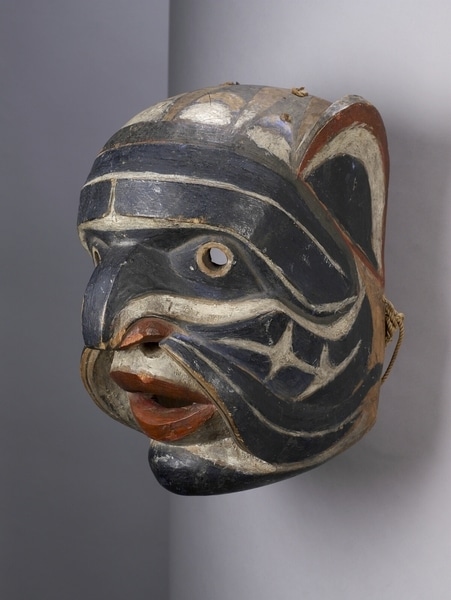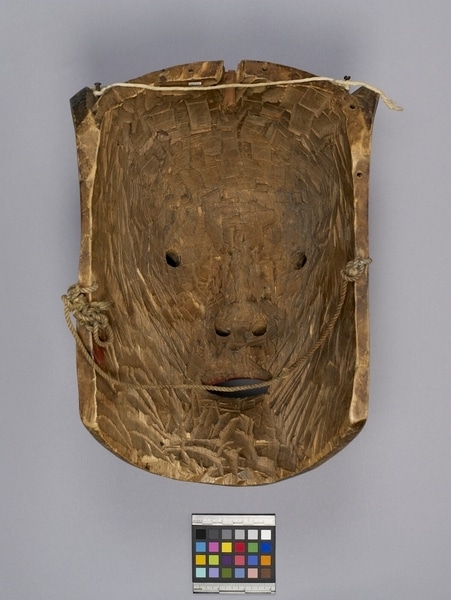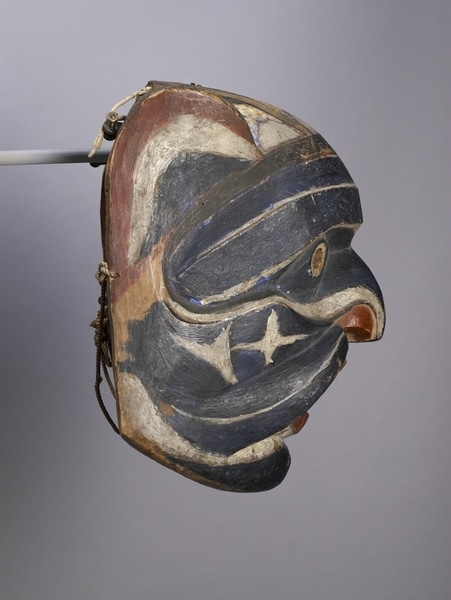Mask Item Number: 1611/1 from the MOA: University of British Columbia




Description
Q'umukwa (Chief of the Undersea World) mask. Deeply carved and painted mask with a large bulbous nose, sweeping brows, prominent cheeks, deeply layered planes, a receding forehead and jaw, and an open, projecting mouth with a fin-like fold on either side. Bear-like ears and small round cutout eyes. Black is overpainted on ultramarine blue with white, red and blue details. Nails on top with fibre remnants and cords attached to back.
History Of Use
The Q'umukwa mask is usually shown during a sisawk, or chief’s ceremonial, in which families display their rights to status, wealth and power by representing smayustas, ancestral origin stories, in dance and song. It is said that Q’umukwa lives beneath the ocean in a house made of copper, wears an enormous hat and has authority over all undersea creatures. The Nuxalk Tallyuumc people – whose original village, Talyu, was located at the end of a long inlet now known as South Bentinck Arm, the name given by George Vancouver in 1793 – have a smayusta that ties their own history to Q’umukwa, Chief of the Undersea World, or Wealthy One. That complex and lengthy narrative, only briefly summarized here, tells of a young male ancestor worried that he will not live up to the fame of his father. He leaves the village to pine, but then sees Q’umukwa’s copper house rise up from the water. The young man is invited in by a seal; there he witnesses the sea creatures dancing, and is bestowed with supernatural rights and privileges. When he returns home, he builds a replica of Q’umukwa’s house and becomes a highly respected chief.
Iconographic Meaning
This mask depicts the supernatural being Q’umukwa, the Nuxalk name for “Chief of the Undersea World” or “Wealthy One.”
Narrative
The mask is documented as having been gifted to a school teacher in Bella Coola, Agnes Balkwill, between 1914 and 1915; her descendants eventually sold it, and MOA purchased it from a Vancouver gallery in 1994.
Item History
- Made in Bella Coola, British Columbia, Canada during 1890
- Owned by Derek Simpkins Gallery of Tribal Art before June 16, 1994
- Received from Derek Simpkins Gallery of Tribal Art (Seller) and Museum of Anthropology Shop Volunteers (Funding source) on June 16, 1994
What
- Name
- Mask
- Identification Number
- 1611/1
- Type of Item
- mask
- Material
- alder wood, paint, fibre and iron metal
- Overall
- height 36.0 cm, width 27.0 cm, depth 25.0 cm
Who
- Culture
- Nuxalk
- Previous Owner
- Derek Simpkins Gallery of Tribal Art
- Received from
- Derek Simpkins Gallery of Tribal Art (Seller) and Museum of Anthropology Shop Volunteers (Funding source)
Where
- Holding Institution
- MOA: University of British Columbia
- Made in
- Bella Coola, British Columbia, Canada
When
- Creation Date
- during 1890
- Ownership Date
- before June 16, 1994
- Acquisition Date
- on June 16, 1994
Other
- Condition
- fair
- Accession Number
- 1611/0001